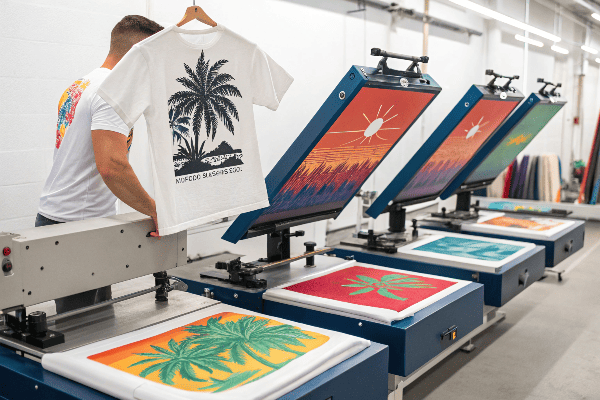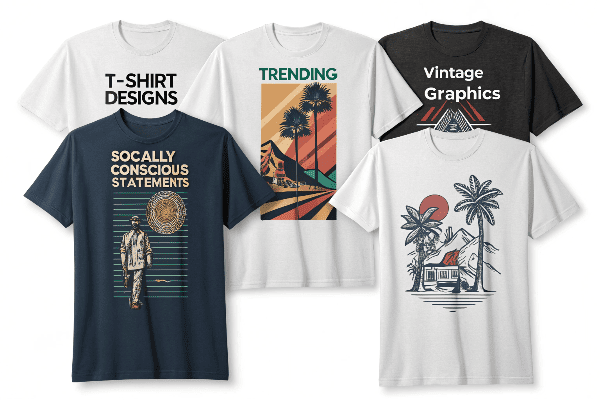Struggling to create T-shirt designs that truly stand out in today’s competitive market? You’re not alone in this challenging pursuit of capturing customer attention.
The secret to designing trendy T-shirts lies in understanding current market trends, implementing innovative printing techniques, and adding your unique creative perspective that resonates with your target audience.

I’ve spent years in the apparel manufacturing industry, and I’ve learned that staying ahead of design trends is crucial for success. Let me share some insights that will transform your T-shirt design approach.
Table of Contents
- What Are the Most Popular T-Shirt Printing Techniques Right Now?
- Which Design Elements Are Trending in T-Shirt Fashion?
- How Can You Create Sustainable and Eco-Friendly T-Shirt Designs?
- Conclusion
What Are the Most Popular T-Shirt Printing Techniques Right Now?
Are you losing potential customers because you’re using outdated printing methods? The right technique can elevate your design from ordinary to extraordinary.
The most popular T-shirt printing techniques1 currently dominating the market include DTG (Direct-to-Garment), screen printing, sublimation, and heat transfer vinyl, each offering unique advantages for different design requirements and production scales.

Breaking Down the Top Printing Methods
When selecting the ideal printing technique for your T-shirt designs, it’s important to understand the strengths and limitations of each method. Let me guide you through the options based on my experience working with global brands.
DTG (Direct-to-Garment) Printing
DTG printing has revolutionized the custom T-shirt industry. This technique works like an inkjet printer but for fabric, allowing for intricate, multi-colored designs with photographic quality. I’ve seen a significant increase in DTG printing requests over the past year, especially for designs with complex gradients and detailed illustrations.
| Advantages | Limitations |
|---|---|
| Perfect for complex, multi-colored designs | Higher cost per unit for large orders |
| No minimum order quantities | Works best on 100% cotton fabrics |
| Quick turnaround time | Print durability can be less than screen printing |
| Excellent for photographic images | Colors may not be as vibrant on dark garments |
Screen Printing
Screen printing remains the industry standard for large orders. The process involves creating a stencil (screen) for each color in your design and applying layers of ink. In our production facility, we’ve refined this technique to achieve exceptional quality even for the most demanding clients.
| Advantages | Limitations |
|---|---|
| Cost-effective for large quantities | Higher setup costs for small runs |
| Extremely durable prints | Limited color options per design (typically) |
| Vibrant colors even on dark fabrics | Not ideal for photographic or gradient images |
| Works well on various fabric types | Longer setup time |
Sublimation Printing
Sublimation has gained tremendous popularity, especially for all-over prints and performance wear. This technique converts solid ink directly to gas, which then bonds with polyester fibers. I’ve seen remarkable results when using this method for athletic wear and fashion pieces.
| Advantages | Limitations |
|---|---|
| Unlimited colors with no extra cost | Works primarily on white/light polyester fabrics |
| Permanent prints that won’t crack or fade | Not effective on cotton or dark garments |
| Perfect for all-over designs | Higher equipment investment |
| Ideal for performance fabrics | Limited to synthetic materials (mainly polyester) |
Heat Transfer Vinyl (HTV)
HTV has become increasingly popular for custom one-offs and small batch productions. This method involves cutting designs from colored vinyl sheets and heat-pressing them onto garments. I’ve found this technique particularly useful for names, numbers, and simple graphics.
| Advantages | Limitations |
|---|---|
| Great for small runs and personalization | Not cost-effective for large quantities |
| Easy to apply with minimal equipment | Limited to vector designs (no gradients) |
| Durable and washable | Can feel heavy on the garment |
| Works well on various fabric types | Multiple colors require layering |
Which Design Elements Are Trending in T-Shirt Fashion?
Feeling overwhelmed by constantly changing fashion trends? Keeping up with evolving consumer preferences can be daunting without proper insight.
The current T-shirt design landscape favors minimalist aesthetics, vintage-inspired graphics, customized typography, and statement designs that reflect social consciousness, allowing wearers to express their values and personal style.

Current Design Trends Worth Implementing
Based on my work with fashion brands across different markets, I’ve identified several design elements that have shown consistent popularity and growth potential.
Minimalist Designs with Bold Typography
Less is definitely more in current T-shirt design trends. I’ve noticed a significant shift toward clean, typographic designs that make a statement without overwhelming graphics. Bold, custom typography paired with simple elements creates memorable designs that appeal to fashion-conscious consumers.
Some examples I’ve successfully implemented include:
- Single-word statements in dramatic, oversized fonts
- Clever phrases in contrasting typographic styles
- Abstract letter forms that double as graphic elements
The key is balancing negative space with impactful type treatment. When designing for our clients, I recommend limiting the color palette to two or three complementary colors for maximum impact.
Vintage and Retro-Inspired Graphics
The nostalgic appeal of vintage-inspired designs continues to resonate strongly with consumers. I’ve seen exceptional market response to designs featuring:
- Distressed prints that mimic well-worn favorites
- Color schemes reminiscent of specific decades (70s oranges and browns, 80s neons, 90s pastels)
- Classic iconography with a contemporary twist
When creating retro-inspired designs, authenticity is crucial. Research the visual language of the era you’re referencing and incorporate genuine period elements rather than generic "old-looking" graphics.
Statement Designs with Social Consciousness
Modern consumers increasingly use their clothing as an extension of their values and beliefs. T-shirts that make statements about social issues, environmental concerns, or cultural identity have shown remarkable staying power in the market.
I’ve helped develop successful campaigns featuring:
- Subtle environmental messaging through nature-inspired imagery
- Cultural celebration designs that honor specific traditions
- Positive affirmations and messages promoting mental health awareness
The most effective statement designs balance their message with aesthetic appeal, avoiding overly literal or heavy-handed approaches.
How Can You Create Sustainable and Eco-Friendly T-Shirt Designs?
Are environmental concerns causing you to lose environmentally conscious customers? The demand for sustainable fashion continues to grow at an unprecedented rate.
Creating eco-friendly T-shirt designs involves selecting organic or recycled materials, implementing water-based or eco-solvent inks, minimizing waste through efficient design planning, and clearly communicating your sustainable practices to increasingly environmentally conscious consumers.

Practical Approaches to Sustainable T-Shirt Design
In our manufacturing facilities, we’ve made significant investments in sustainable practices. Here are concrete steps you can take to create more eco-friendly T-shirt designs while maintaining quality and profitability.
Choosing Sustainable Materials
The foundation of any eco-friendly T-shirt begins with the fabric. I’ve seen excellent results with:
| Material Type | Environmental Benefits | Design Considerations |
|---|---|---|
| Organic Cotton | Grown without harmful pesticides | Excellent print surface for most techniques |
| Recycled Polyester | Reduces plastic waste | Ideal for sublimation printing |
| Hemp Blends | Low water usage, pesticide-free | Slightly textured surface affects detail |
| Bamboo Viscose | Renewable resource, biodegradable | Soft surface requires gentle printing |
When discussing materials with our clients, I always emphasize that sustainable fabrics have improved dramatically in quality and print compatibility over the past few years. The performance difference between conventional and eco-friendly materials is now minimal for most applications.
Eco-Friendly Printing Techniques
The printing method you choose significantly impacts the environmental footprint of your T-shirts:
-
Water-based inks contain fewer harmful chemicals and produce softer prints that breathe with the fabric. I’ve found them particularly effective for vintage-style designs.
-
PVC-free plastisol alternatives provide the durability of traditional plastisol without the environmental concerns.
-
Low-waste digital printing methods like DTG reduce chemical usage and minimize leftover ink.
In our production process, we’ve found that combining water-based inks with efficient print planning can reduce our environmental impact while maintaining the vibrant designs our clients expect.
Design for Longevity
One often overlooked aspect of sustainable T-shirt design is creating styles that remain relevant beyond a single season. I advise our clients to:
- Develop timeless graphics that won’t quickly appear dated
- Create designs that withstand numerous washing cycles without significant degradation
- Consider versatility in how the garment can be styled and worn
This approach not only reduces environmental impact but also increases the perceived value of your products to consumers who are increasingly concerned about fast fashion.
Conclusion
Designing trendy T-shirts requires balancing current printing techniques, popular design elements, and sustainable practices while maintaining your unique creative vision and brand identity.
-
Explore this link to discover innovative T-shirt printing techniques that can elevate your designs and attract more customers. ↩


